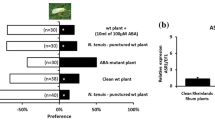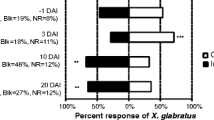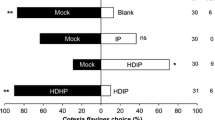Abstract
Orius laevigatus is a generalist predator that is widely used in augmentative strategies against the key pest of sweet pepper, Frankliniella occidentalis. Despite being a zoophytophagous predator, the phytophagous behavior of O. laevigatus has not been previously explored in depth nor has the impact of phytophagy on plant physiology. Here, the hierarchical significance of O. laevigatus feeding on sweet pepper is compared with other behaviors. O. laevigatus spends the majority of its time (38%) feeding on apical meristems and apical fresh leaves, which were also preferred residence locations. Here, the phytophagous feeding behavior of O. laevigatus on sweet pepper is shown to trigger defensive responses in the plant. These O. laevigatus plant-induced defenses are then shown to contribute to the repellence or attraction of pests or natural enemies, respectively. Specifically, O. laevigatus-punctured sweet pepper plants induce repellency for the whitefly Bemisia tabaci and the thrips species F. occidentalis. In contrast, the whitefly parasitoid Encarsia formosa was significantly attracted to O. laevigatus-punctured plants. The plant responses to O. laevigatus punctures include the release of an altered blend of volatiles and activation of the jasmonic acid and salicylic acid signalling pathways. These results highlight an interesting facet to the biology of O. laevigatus, in which the ability of the predator to induce defensive responses in sweet pepper plants may serve to improve the biological control of both thrips and whiteflies.




Similar content being viewed by others
Change history
11 March 2021
A Correction to this paper has been published: https://doi.org/10.1007/s10340-021-01357-4
References
Ardanuy A, Albajes R, Turlings TC (2016) Innate and learned prey-searching behavior in a generalist predator. J Chem Ecol 42:497–507
Armer CA, Wiedenmann RN, Bush DR (1998) Plant feeding site selection on soybean by the facultatively phytophagous predator Orius insidiosus. Entomol Exp Appl 86:109–118
Arnó J, Roig J, Riudavets J (2008) Evaluation of Orius majusculus and O. laevigatus as predators of Bemisia tabaci and estimation of their prey preference. Biol Control 44:1–6
Calvo J, Bolckmans K, Belda JE (2009) Development of a biological control-based integrated pest management method for Bemisia tabaci for protected sweet pepper crops. Entomol Exp Appl 133:9–18
Chambers R, Long S, Helyer NL (1993) Effectiveness of Orius laevigatus (Hem, Anthocoridae) for the control of Frankliniella occidentalis on cucumber and pepper in the UK. Biocontrol Sci Technol 3:295–307
Cocuzza G, De Clercq P, Veire M, de Cock A, Degheele D, Vacante V (1997) Reproduction of Orius laevigatus and Orius albidipennis on pollen and Ephestia kuehniella eggs. Entomol Exp Appl 82:101–104
De Puysseleyr V, Hofte M, De Clercq P (2011) Ovipositing Orius laevigatus increase tomato resistance against Frankliniella occidentalis feeding by inducing the wound response. Arth-Plant Int 5:71–80
Evans E, Dixon AFG (1986) Cues for oviposition by ladybird beetles (Coccinellidae): response to aphids. J Anim Ecol 55:1027–1034
Frescata C, Mexia A (1996) Biological control of thrips (Thysanoptera) by Orius laevigatus (Heteroptera: Anthocoridae) in organically grown strawberries. Biol Agric Hortic 13:141–148
Fritshe ME, Tamó M (2000) Influence of thrips prey species on the life-history and behaviour of Orius albidipennis. Entomol Exp Appl 96:111–118
Gerling D, Alomar O, Arnó J (2001) Biological control of Bemisia tabaci using predators and parasitoids. Crop Prot 20:779–799
Gill R, Gupta K, Taggar GK, Taggar MS (2010) Role of oxidative enzymes in plant defenses against herbivory. Acta Phytopathol Entomol Hung 45:277–290
Hemptinne J, Dixon AFG, Coffin J (1992) Attack strategy of ladybird beetles (Coccinellidae): factors shaping their numercial response. Oecol 90:238–245
Hernández LM, Stonedahl GM (1999) A review of the economically important species of the genus Orius (Heteroptera: anthocoridae) in East Africa. J Nat Hist 33:543–568
Jonathan GL, Fergen J (2006) The oviposition behavior of the predator Orius insidiosus: acceptability and preference for different plants. Biocontrol 51:217–227
Kessler A, Baldwin IT (2001) Defensive function of herbivore-induced plant volatile emissions in nature. Science 291:2141–2144
Kessler A, Baldwin IT (2002) Plant responses to insect herbivory: the emerging molecular analysis. Annu Rev Plant Biol 53:299–328
Kigathi RN, Unsicker SB, Reichelt M, Kesselmeier J, Gershenzon J, Weisser WW (2009) Emission of volatile organic compounds after herbivory from Trifolium pratense (L.) Under laboratory and field conditions. J Chem Ecol 35:1335–1348
Lee DH, Nyrop JP, Sanderson JP (2014) Non-consumptive effects of the predatory beetle Delphastus catalinae (Coleoptera: coccinellidae) on habitat use patterns of adult whitefly Bemisia argentifolii (Hemiptera: Aleyrodidae). Appl Entomol Zool 49:599–606
Lundgren JG, Fergen JK, Riedell WE (2008) Influence of plant anatomy on oviposition and reproductive success of the omnivorous bug Orius insidiosus. Anim Behav 75:1495–1502
McCormick AC, Irmisch S, Reiecke A, Boeckler AG, Veit D, Reichelt M, Köllner TG, Hansson BS, Gershenzon J, Unsicker SB (2014) Herbivore-induced volatile emission in black poplar: regulation and role in attracting herbivore enemies. Plant Cell Environ 37:1909–1923
Nakashima Y, Hirose Y (2002) Sex differences in foraging behaviour and oviposition site preference in an insect predator, Orius sauteri. Entomol Exp Appl 106:79–86
Naselli M, Urbaneja A, Siscaro G, Jaques JA, Zappalà L, Flors V, Pérez-Hedo M (2016) Stage-related defense response induction in tomato plants by Nesidiocoris tenuis. Int J Mol Sci 17:1210
Ninkovic V, Feng Y, Olsson U, Pettersson J (2013) Ladybird footprints induce aphid avoidance behavior. Biol Control 65:63–71
Nomikou M, Janssen A, Sabelis MW (2003) Herbivore host plant selection: whitefly learns to avoid host plants that harbor predators of her offspring. Oecologia 136:484–488
Pappas M, Steppuhn A, Geuss D, Topalidou N, Zografou A, Sabelis MW, Broufas GD (2015) Beyond Predation: the Zoophytophagous predator Macrolophus pygmaeus induces tomato resistance against spider mites. PLoS ONE 10(5):e0127251
Pappas M, Steppuhn A, Broufas GD (2016) The role of phytophagy by predators in shaping plant interactions with their pests. Commun Integr Biol 9(2):e1145320
Pérez-Hedo M, Urbaneja A (2015) Prospects for predatory mirid bugs as biocontrol agents of aphids in sweet peppers. J Pest Sci 88:65–73
Pérez-Hedo M, Urbaneja-Bernat P, Jaques JA, Flors V, Urbaneja A (2015a) Defensive plant responses induced by Nesidiocoris tenuis (Hemiptera: miridae) on tomato plants. J Pest Sci 88:543–554
Pérez-Hedo M, Bouagga S, Jaques JA, Flors V, Urbaneja A (2015b) Tomato plant responses to feeding behavior of three zoophytophagous predators (Hemiptera: miridae). Biol Control 86:46–51
Ponzio C, Gols R, Weldegergis BT, Dicke M (2014) Caterpillar-induced plant volatiles remain a reliable signal for foraging wasps during dual attack with a plant pathogen or non-host insect herbivore. Plant Cell Environ 37:1924–1935
Riudavets J (1995) Predators of Frankliniella occidentalis (Perg.) and Thrips tabaci Lind: a review. Wag Ag Un P 95:43–87
Sanchez JA, Lacasa A (2002) Modelling population dynamics of Orius laevigatus and O. albidipennis (Hemiptera: anthocoridae) to optimize their use as biological control agents of Frankliniella occidentalis (Thysanoptera: Thripidae). Bull Entomol Res 92:77–88
Sanchez JA, Alcazar A, Lacasa A, Llamas A, Bielza P (2000) Integrated pest management strategies in sweet pepper plastic houses in the Southeast of Spain. IOBC/WPRS Bull 23:21–27
Sendoya F, Freitas VL, Oliveira PS (2009) Egg-laying butterflies distinguish predaceous ants by sight. Am Nat 174:134–140
Shivaji R, Camas A, Ankala A, Engelberth J, Tumlinson JH, Williams WP, Wilkinson JR, Luthe DS (2010) Plants on constant alert: elevated levels of jasmonic acid and jasmonate-induced transcripts in caterpillar resistant maize. J Chem Ecol 36:179–191
Vacante V, Cocuzza GE, De Clercq P, Van De Veire M, Tirry L (1997) Development and survival of Orius albidipennis and O. laevigatus (Het.: anthocoridae) on various diet. Entomophaga 42:493–498
van der Blom J, Ramos M, Ravensberg W (1997) Biological pest control in sweet pepper in Spain: introduction rates of predators of Frankiniella occidentalis. IOBC/WPRS Bull 20:196–202
van der Blom J, Robledo A, Torres S, Sánchez JA (2009) Consequences of the wide scale implementation of biological control in greenhouse horticulture in Almeria, Spain. IOBC/WPRS Bull 49:9–13
van Lenteren J, Bueno VH (2003) Augmentative biological control of arthropods in Latin America. Biocontrol 48:123–139
van Lenteren JC, Bolckmans K, Köhl J, Ravensberg W, Urbaneja A (2017) Biological Control using invertebrates and microorganisms: plenty of new opportunities. BioControl In press. doi:10.1007/s10526-017-9801-4
Venzon M, Janssen A, Sabelis MW (2002) Prey preference and reproductive success of the generalist predator Orius laevigatus. Oikos 97:116–124
War AB, Sharma HC, Paulraj MG, War MH, Ignacimuthu S (2011) Herbivore induced plant volatiles. Their role in plant defense for pest management. Plant Signal Behav 6:1973–1978
Wasserberg G, White L, Bullard A, King J, Maxwell R (2013) Oviposition site selection in Aedes albopictus (Diptera: culicidae): are the effects of predation risk and food level independent? J Med Entomol 50:1159–1164
Werner EE, Peacor SD (2003) A review of trait-mediated indirect interactions in ecological communities. Ecology 84:1083–1100
Yano E, Jiang N, Hemerik L, Mochizuki M, Mitsunaga T, Shimoda T (2005) Time allocation of Orius sauteri in attacking Thrips palmi on an eggplant leaf. Entomol Exp Appl 117:177–184
Zeng F, Cohen AC (2000) Demonstration of amylase from the zoophytophagous anthocorid Orius insidiosus. Arch Int Physiol Biochim 44:9–136
Acknowledgements
The research leading to these results was partially funded by the Spanish Ministry of Economy and Competitiveness (AGL2014-55616-C3) and the Conselleria d’Agricultura, Pesca i Alimentació de la Generalitat Valenciana. The authors thank Dr. Javier Calvo (KOPPERT BS, Spain) for supplying the insects, Dr. Pablo Bielza (Universidad Politécnica de Cartagena, Spain) for thrips colonies, Dimitrios Afentoulis, Zoi Thanou and Konstantinos Birmpilis (Erasmus + from Agricultural University of Athens) for providing support in the behavior experiments and Alice Mockford (University of Worcester) and two anonymous reviewers for their constructive review of this manuscript. MP-H was the recipient of a postdoctoral fellowship from the MEC (Juan de la Cierva program- FPDI-2013-17968) and SB was the recipient of a grant from Russell IPM Ltd.
Author information
Authors and Affiliations
Corresponding author
Ethics declarations
Conflict of interest
The authors declare that they have no conflict of interest.
Informed consent
Informed consent was obtained from all individual participants included in the study.
Human and animal rights
This article does not contain any studies with human participants or animals performed by any of the authors.
Additional information
Communicated by D. C. Weber.
Rights and permissions
About this article
Cite this article
Bouagga, S., Urbaneja, A., Rambla, J.L. et al. Orius laevigatus strengthens its role as a biological control agent by inducing plant defenses. J Pest Sci 91, 55–64 (2018). https://doi.org/10.1007/s10340-017-0886-4
Received:
Accepted:
Published:
Issue Date:
DOI: https://doi.org/10.1007/s10340-017-0886-4




